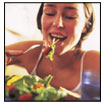Endometriosis risk reduced if
you eat more fruit and green vegetables
July 15, 2004
Naples
Women may be able to lower
their risk of endometriosis by eating more fresh fruit and green vegetables.
But, eating red meat and ham appears to increase their risk, according to a
study published (Thursday 15 July) in Europe's leading reproductive medicine journal Human Reproduction[1]. The researchers, from
Milan in Italy, have now called for a prospective study to investigate
further the possible links between diet and endometriosis.
reproductive medicine journal Human Reproduction[1]. The researchers, from
Milan in Italy, have now called for a prospective study to investigate
further the possible links between diet and endometriosis.
Endometriosis is a painful and distressing condition whereby endometrial
tissue, which under normal circumstances is found only in the lining of the
womb, develops outside the uterus and attaches itself to ligaments and
organs in the abdominal cavity. This tissue responds to the menstrual cycle
as though it were still inside the uterus. The repeated growth and
disintegration of endometrial tissue in the abdomen can cause bleeding,
pain, inflammation, adhesions and infertility. It is estimated to affect up
to five in every 100 women in Italy and probably in the rest of Europe.
The researchers used interviews and structured questionnaires to compare the
medical and reproductive history, lifestyle and diet of over 500 women with
clinically confirmed endometriosis with a group of over 500 matched controls
with no history of the disease.
Lead researcher Dr Fabio Parazzini from the Gynaecologic Clinic of the
University of Milan, explained: "We asked women about their diet in the year
leading up to the interview. In particular, we asked how many times a week
they ate portions of selected dietary items, including the major sources of
retinoids and carotenoids in the Italian diet. We also asked about their
alcohol and coffee consumption.
"We divided their intake into portions approximating to low, intermediate
and high intake of the various dietary factors[2]. What we found was that
there was a 40% relative reduction in risk of endometriosis in women with
higher consumption of green vegetables and fresh fruit. But, for those with
a high intake of beef, other red meat and ham, there was an increase of
about 80-100 percent in relative risk.
"With a prevalence of 5% in endometriosis in Italy, this means that if our
findings are confirmed in prospective studies, we have the potential to cut
the prevalence of endometriosis to around 3-4%, which would mean about
200,000 prevalent cases (and about 10,000 new cases a year) fewer in Italy
and probably 800,000 fewer prevalent cases in Europe.
There was no significant link between endometriosis and consumption of milk,
liver, carrots, cheese, fish, whole-grain foods, coffee or alcohol and no
association with butter, margarine or oil.
Dr Parazzini said there were some limitations in the study: the diet section
was restricted to a few selected indicator foods and there was no estimate
of portion size (therefore no estimate of the total intake in calories).
However, since the possible relationship between diet and endometriosis was
probably not known to the interviewers or the majority of women interviewed
this was unlikely to have biased the results.
The association between vegetables, fruit and meat was unlikely to be due to
chance because the researchers analysed several dietary items. However, it
was possible there was a 'healthy woman' effect as a high intake of green
vegetables, fruit and fish may be generally indicators of more
health-conscious attitudes. Also, women who paid closer attention to their
health may be more likely to have endometriosis diagnosed.
"However, despite these limitations, our study does suggest that there is
some link between diet and risk of endometriosis and indicates that we now
need a proper prospective interventional investigation to study these
factors. Endometriosis is a distressing condition that affects the quality
of life for many women and if there are adjustments that can be made in the
diet to lower the risk it is vital that we gain really firm evidence about
which foods protect and which foods increase risk."
[1] Selected food intake and risk of endometriosis. Human Reproduction.
DO1:10.1093/humrep/deh395. Vol.19, No. 8. Pp 1755-1759.
[2] The analysis was based on the best possible approximations of tertiles.
Milk 0,0.5-6 and around 7 portions a week; meat 0-3,4-6 and around 7
portions a week; liver 0 and around 0.5 portions a week; carrots 0, 1 and
around 2 portions week; green vegetables 0-6,7-12 and around 13 portions a
week; fresh fruit around 6, 7-13 and around 14 portions a week; eggs 0, 1
and around 2 a week; ham around 1, 2 and around 3 portions a week; fish 0,1
and around 2 portions as week; cheese around 2,3-5 and around 6 portions a
week. Alcohol was analysed in accordance with ethanol content i.e. 125ml of
wine = 333ml of beer = 40ml of spirits = 15g of pure alcohol.
Notes:
1 PDF version of this press
release and full embargoed text of the paper with complete results can be
found from 09:00hrs London time Tuesday 13 July at: http://www3.oup.co.uk/eshre/press-release/jul043.pdf
or is available from Margaret Willson.
2 Human Reproduction is a monthly journal of the European Society of Human
Reproduction and Embryology (ESHRE). Please acknowledge Human Reproduction
as a source. Dr Helen Beard, Managing Editor. Tel: 44-195-421-2404 Email:
[email protected]
3 ESHRE's website is: http://www.eshre.com
4 Abstracts of other papers in ESHRE's three journals: Human Reproduction,
Molecular Human Reproduction & Human Reproduction Update can be accessed
post embargo from http://www3.oup.co.uk/eshre/ Full text of papers available
on request from Margaret Willson.
Contact (media inquiries only): Margaret Willson
Email: [email protected]
Tel: 44-153-677-2181
Mobile: 44-797-385-3347
Home Tel: 44-153-677-0851
European Society for Human Reproduction and Embryology